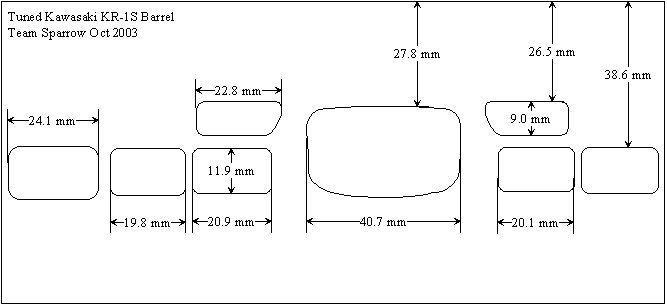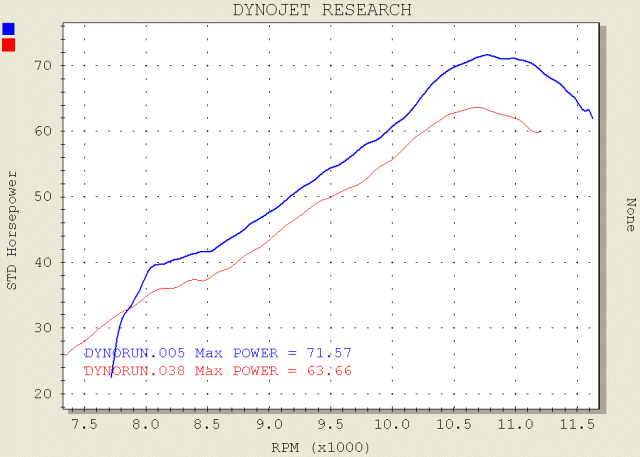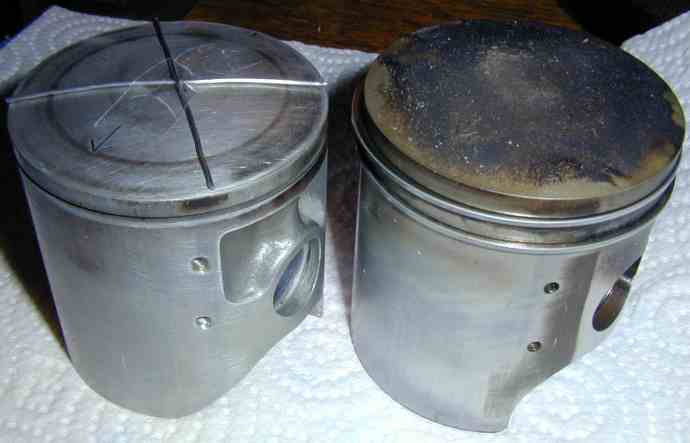

Engine Tuning Pt II(Open up)
Having got some cold air in to the airbox you now need to pump it more efficiently. If you ever get a chance have a look at a set of modern barrels of a GP125 or 250. There is virtually no metal where the ports are - it is all port. You get a few bridges between the ports that are a mm or so wide whose only purpose is to stop the ring popping out. On the KR the gap between ports is huge, it's a road bike and needs to do lots of miles. The easiest way of making it flow more gas is to widen the ports (at this stage don't even think of raising the port heights). The KR has 5 transfer ports two front, two rear and a boost port. I don't think you can widen the front ports much whilst maintaining the flow angle as there isn't a lot of metal between the KIPS valve and the port - consequently I haven't tried this. However you can widen the rear port (Green Circle is modded port, Red circle is standard port) - reduce the gap between the rear port and the boost port and re-profile it to take out the abrupt step. Leave about 2 ~ 3 mm of metal just to hold the ring in place. If you do this mod you won't be able to run standard pistons anymore as the rings will catch. You need to go over to the TZ 26J single ring pistons.

Having worked with the KR for a number of years I
have a few ideas as to what I think works and what doesn't. This is
all being incorporated in my 2004 barrels see the port map(this
thinking is Oct 2003 - we will be trying a bit more exhaust lead on
a set of development barrels. We have found that this knocks off
power between 8000 and 10000 in exchange for peak between 10000 and
11000 however this time will try a set of expansions that give mid
range so hope two work together).
To get a port map I line the
barrel with overlapping strips of masking tape. Gently with a soft
pencil or crayon take a rubbing of the ports. Carefully peel the
masking tape off as a cylinder. Split it at an appropriate point
using a pair of scissors and stick on a bit of paper. I then scan
this image and put it into a drawing package. After a little
rotation to get the alignment correct I then draw in the ports using the
image as a template. The result is the port map shown. I have done
very little to the primary transfer other than raise the height - so
the difference in width is down to factory tolerances. The ports
will be matched before the barrel is finished. So what have I done -
Transfers lifted about 0.9mm and corners tightened, main exhaust
lifted 0.5mm (the roof of the exhaust port was and still is a bit to
square which may explain the wear that occured on the barrel above
the exhaust port raising the port 0.5mm has allowed me to put a
little more radius on the top), Kips ports squared off and widened.
A lot of work went into the barrel on getting the angles on the
walls of Transfer 2 right, transfer 2 is widened (I will post a
drawing when I get one done). A lot of work also goes into tidying
up the barrel, knifeedging etc.

The port map from the set of barrels that made 70hp. The map was taken before I had finished the recent tweaks to the barrels, but the only changes are corner radius of transfers and Kips ports which I have sharpened, heights and widths remain the same. I think the Kips ports are too high so I am losing a bit of drive between 8500 and 10000 (hence the lower Kip port height in the barrels I am working on. To make up for the loss of area on the new barrels I am making the ports wider).

These barrels on a stock bottom end made 63hp December last year. Only change for this year was tidying up of ports to make sure they were same height etc, sharpening of corners and running the barrels on my race bottom end (flowed cases, reworked reed block and 35mm carbs). Difference between December 02 (red) and November 03 (blue) is shown below.
More mods are planned, a few subtle tweaks to the porting plus we didn't get to time to try the expansions. Next visit to dyno in January when we will try next tweaks plus the expansions and a fully programmable ignition with TPS, gear selectable maps and variable power valve timing.

Running TZ pistons with a stock head will reduce the squish very slightly as they are approximately 0.3~0.4 mm (See the table below for changes)taller than stock pistons. This is good as the stock engine runs a very large squish. Though the pistons are slightly higher you shouldn't have a problem with compression as they have a slightly flatter dome (to get the best performance and reliability your head should be worked to give you the correct squish angle and head volume appropriate for the fuel you run). Check your clearance by taping solder to the top of the piston and turning the engine over slowly. This will squash the solder against the head - tape the solder in a cross else you will get a false reading as the piston will rock. Measure the thickness of the solder and that will give you your squish clearance. If you are revving to 11,500 don't go below 0.65 mm. If you go to 0.55mm (the bare minimum) make sure you change the little end and gudgeon pin regularly and check the piston for contact. The TZ piston has the pin at the back so the ring ends lie in the boost port. The pistons are a bit noisy but should last ok. Change the rings regularly, 350 ~ 400 miles racing, probably about a 1000 miles road use (The TZ pistons showed less wear after a season racing than a set of standard pistons after half a season). I use a standard Kawasaki little end bearing and gudgeon pin. The Kwack item is lighter than the TZ item and hence doesn't unbalance the system. You will also need to put a few holes into the TZ piston to allow the oil through. Copy the standard KR piston for the position (see piccy). The KR heads warp fairly easily so it is best to remove both barrels and head at once, i.e. leave the head in place. This also saves you a head gasket.

Ok been and measured some pistons, standard and
TZ types 26J, 59W, 3TC, 3AK, and 4DP. Measurements are in the table.
The deck height, as I refer to it, is the distance between the top
of the piston pin hole and the very edge of the piston
crown.
| Piston Type | Deck Ht | Weight g | Dome radius mm |
| Standard | 21.6 | 150 | 120 |
| 26J | 22.1 | 150 | 150 |
| 59W | 22 | 138 | 150 |
| 3TC | 20 | 138 | 150 |
| 3AK | 20 | ? | 150 |
| 4DP | 20 | 152 | Flat /raised |
| RGV | 20.5 | Flat/Flat |
Return to KR1-S FORUM Return to Main Index
This document WAS maintained by Mark
Jordan.
Material Copyright © 2003 Mark
Jordan